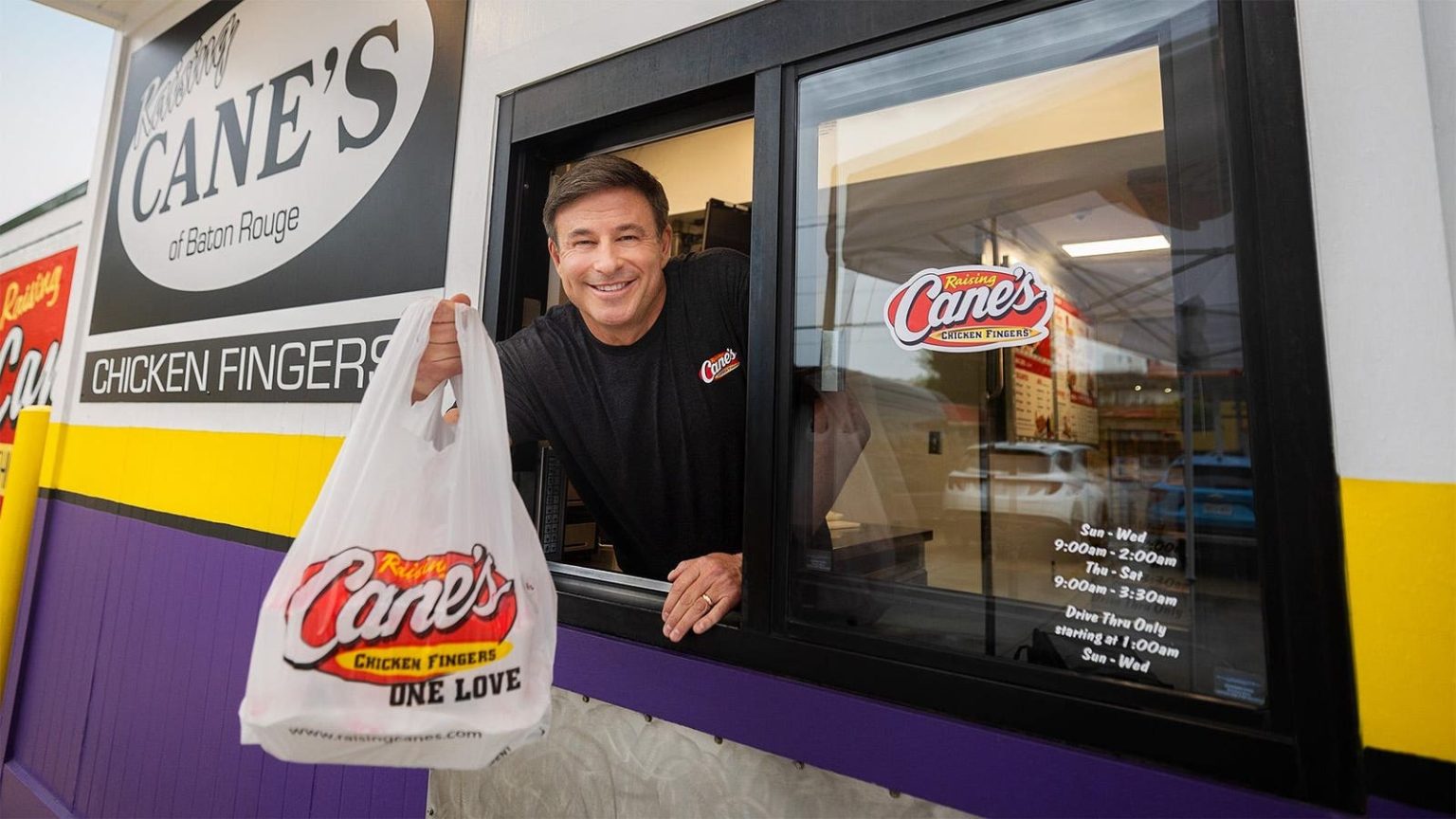From Boilermaker to Billionaire: The Extraordinary Rise of Raising Cane’s Todd Graves
In the heart of Baton Rouge, Louisiana, Todd Graves walks through the original Raising Cane’s restaurant with the enthusiasm of someone who still can’t believe his luck. “I built this structure,” he says proudly, pointing out the menu board he personally erected 29 years ago, the neon “chicken fingers” sign he designed at a local shop, and even the spot where he carved his name into a table. This isn’t just nostalgia—it’s a testament to the journey of a man who was once dismissed as “a dumb kid with a bad idea.” Today, that “bad idea” has transformed into a fast-food empire worth billions, making Graves America’s richest restaurateur with a net worth of $22 billion. His success story is a masterclass in perseverance, focus, and the power of believing in your vision even when no one else does.
Back in the early 1990s, Graves was convinced that a restaurant serving only chicken fingers would be a hit with college students at Louisiana State University. Banks didn’t share his enthusiasm. Undeterred by rejection, Graves took extreme measures to fund his dream. He worked grueling jobs as a boilermaker in Los Angeles oil refineries and then as a commercial salmon fisherman in Alaska’s dangerous Bristol Bay. “We rammed boats, boats rammed us. We were catching so much fish,” Graves recalls of the perilous experience that eventually yielded $50,000 in hard-won savings. This, combined with $90,000 from local investors and a $50,000 Small Business Administration loan, was enough to lease the space near LSU’s campus. Graves and his childhood friend Craig Silvey did everything themselves—installing the menu board, wood-paneled walls, and even bathroom plumbing to save money. When Raising Cane’s opened in August 1996, it made just $30 profit in its first month. But Graves kept going, expanding to a second location with a drive-thru that attracted a more diverse customer base—from tee-ball teams to business professionals.
Three decades later, Raising Cane’s has expanded to more than 900 locations across 42 states, with sales hitting $5.1 billion last year. What’s remarkable is that the average Raising Cane’s generates $6.6 million per location—second only to Chick-fil-A and more than double the revenue of most major fast-food chains. The key to this extraordinary success lies in Graves’ unwavering commitment to simplicity. While most chains continuously expand their menus to cater to every taste, Raising Cane’s has stubbornly maintained the same five items since its inception: chicken fingers, crinkle fries, coleslaw, Texas toast, and a single dipping sauce. Graves hasn’t added a new food item since 2007 (lemonade). “We do one thing—chicken fingers—and we do it better than anybody else,” he explains, adding, “If you try to be all things to all people, you won’t be special.” This focus has operational advantages too. With just a handful of items to manage, Cane’s keeps costs down and maintains obsessive quality control. Fresh chicken is delivered to stores, marinated and hand-battered daily. Toast is buttered and griddled in-house, and workers hand-squeeze lemonade every morning.
Graves’ obsession with details extends far beyond the menu. He personally reviews the kids’ meal toys, oversees the decorations in every restaurant, and writes many of the marketing campaigns himself. This level of control might seem excessive, but it’s central to his business philosophy. While many of his competitors are selling to Wall Street firms—Subway to Roark Capital for over $9 billion, Jersey Mike’s to Blackstone at an $8 billion valuation—Graves can’t imagine ever selling Raising Cane’s. Even his approach to franchising reflects this mentality. Around 2004, he began offering franchises to experienced operators, but by 2016, he couldn’t handle the perceived quality gap. “If we operate our stores at a 95 out of 100 and the franchisees were operating at 85, the 10-point gap drove me crazy,” he admits. He began buying them back, and today just 22 locations in the U.S. are franchised, plus 52 in the Middle East, where local expertise is essential.
The path to success wasn’t always smooth. Graves’ early growth strategy was risky—”I leveraged the heck out of the business,” he acknowledges. When Hurricane Katrina hit in 2005, it knocked 21 of his 28 stores offline, nearly bankrupting the company. He hustled to keep lenders at bay and vowed never to put the business in that position again. To help manage the expanding empire, in 2017 Graves brought on a co-CEO, AJ Kumaran, a seasoned industry executive who handles daily operations while Graves focuses on motivating his 70,000 employees and promoting the brand. Today, Cane’s generates $928 million in EBITDA, easily servicing its $2.6 billion debt load and providing Graves with an estimated $250 million annual dividend. He has invested in some 150 personal ventures, many in real estate, including a $75 million building in Nashville and a $15 million penthouse atop the Four Seasons.
Perhaps the most fascinating aspect of Graves’ approach is his marketing strategy. Rather than expensive national TV campaigns, he prefers supporting local charities ($165 million to date) and partnering with celebrities. What began with Snoop Dogg working a drive-thru in 2021 has evolved into collaborations with more than 80 A-listers annually, from NFL star Travis Kelce to rapper Ice-T. When Post Malone asked for a Cane’s near his Utah home, Graves let him design a bright-pink store and split the profits with him. Even as competition intensifies—with McDonald’s, Wingstop, and even Taco Bell adding chicken tenders—Graves remains steadfast in his approach. His long-term goal is $10 billion in sales and 1,600 stores by 2030, with significant international expansion planned for Europe and Latin America. After 16 straight years of same-store sales growth, Graves sees no reason to change course: “I’m going to keep doing the same thing,” he declares. “And if you do exactly what we do, you better be damn good at it, because we’re relentless.”


